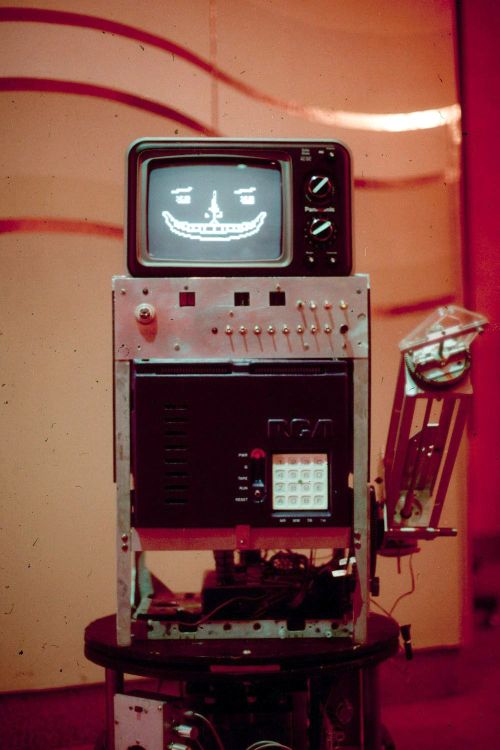
Carol and I were digging out the far dark corners of our walk-in pantry, and an interesting artifact came to hand: A plastic thermos bottle with the following inscription:
It keeps hot food hot, and cold food cold. How does it know? Is it the most “artificially intelligent” object in the galaxy?
At the bottom of the front face was Borland International’s logo. The jug was a teaser for Turbo Prolog, and I think I received it while I was still at PC Tech Journal in the fall of 1986. I had to quote the text here, because as you can see from the photo, a good part of the inscription has been worn away. Why? Because I used it. I used it a lot.
That is not generally the case for swag.
Once I became a computer journalist in 1985, I was offered a lot of swag, and took more of it than I had any need for, mostly to be polite. These were, after all, advertisers and potential advertisers. Carol and I have gotten (and still get) swag from various persons and organizations, and it’s interesting to look around the house and see what we still have, fifteen years after I ceased to have advertisers:
- In the summer of 1976, Carol attended an open house at a local real estate office in Rochester Minnesota, where she was at grad school. They gave her a yellow plastic noodle strainer reading “Joe Maas Gallery of Homes” and a phone number. Almost 39 years later, we still use it to strain noodles and dumplings and anything else that needs to stay in the pot while dumping the water. Joe Maas’s name is long gone to friction and detergent, but I still remember it. For swag, I’d say mission accomplished.
- Seven or eight years ago, we received a plastic flyswatter in the shape of a house from the realtor in Chicago who helped us buy our condo. It’s a little smaller than most flyswatters, meaning that it has less mass and is more maneauverable, as a good many flies have found to their sorrow. I’m not sure I’d want my company name slobbered up with bug guts, but I use it most days in the summer and will never forget Rohn Realty.
- In 1985, Quadram gave me a nice leather reporter’s notebook with their logo on the front. I used to use it a lot for pen-and-ink jotting, until technology made pen-and-ink mostly obsolete. Technology did the same number on Quadram, so I guess it doesn’t matter that I misplaced it some years ago. (I think I know where it is, but I don’t want to dig that deep in a pile that big.)
- Premia gave me a nice little pen knife / nail file / micro-scissors in 1992 or so with the CodeWright logo on one side. It’s still in my desk drawer and I still use it.
- Screwdrivers. I still have and use a pocket screwdriver from PK Ware, as well as the one that came in the box with Windows for Workgroups.
- Thumb drives. These didn’t exist back when still I went to trade shows, but Eric Bowersox gave me a couple of teensy little items that came loaded with just about every piece of documentation AMD was giving away about its processors and motherboards. Double brilliant.
- Canvas bags. Too numerous to mention. All that came to hand just now long outlived their vendors. A particularly good specimen from the 1991 OOPSLA is still my designated hamfest trick-or-treat bag.
Not everything makes good swag. Here are some cautionary pointers:
- Pens. Live fast and die quick; that’s the pen motto. All are long gone, although a spring-loaded Levitra gimmick pen given to me by a doctor friend remains in my Personal Museum of Very Odd Things.
- Coffee mugs. Part of the problem is that everybody gives out coffee mugs, and your swag mug gets lost among all the others, and is eventually given to the local thrift store. The other part of the problem is that coffee mugs aren’t always microwaveable, and if you can’t nuke the brew, that mug is on the short path to oblivion. I gave away the nice OS/2 Warp mug I once had because it was plastic. And early on, swag cups often had foil trim, which catches fire in the microwave. The Borland mug shown above is a very nice item, but man, you should have seen the fireworks when I turned the microwaves loose on it in the early 90s.
- Clothes. Ok, folks, look at me: Am I an XXL? Then why are all these trade-show T-shirts size XXL? Because you can’t stock six sizes at your booth? Well, look at whose canvas bag I’m toting. It isn’t yours, hint hint.
Not all those XXL T-shirts are gone. We still have a couple, and Carol uses them for nightgowns and swimsuit coverups. A famous example has those cute little whatevertheyares from the cover of O’Reilly’s book Sed and Awk. When we were in St. John’s in 1998, a vacationing geek chatted up Carol, hoping that she was that rarest of beings: a beautiful woman who uses sed and awk. (Carol referred him to me. His disappointment was palpable.)
I’m sure there are others in drawers and cabinets around the house. The wonder isn’t that we still have them (we’re legendary packrats) but that such cheap and usually plastic geegaws can actually serve real needs for longer than ten minutes. Borland’s AI thermos will doubtless see ice-water service again this summer, now that it’s no longer in the bottom of a box. Houses have flies, and thus realtors will give away flyswatters. And a swag strainer that sees near-daily use for 38 years with no end in sight? That should be in a glass case in the Vatican, because God in heaven, it’s a miracle.












